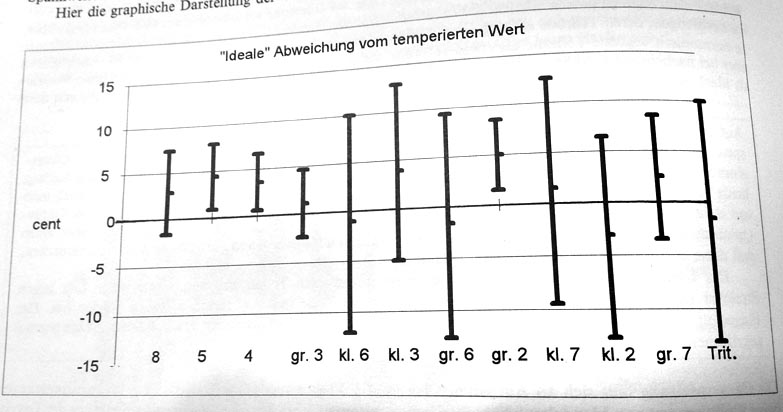 By Partner in Crime I mean our most common collaborator in the traditional repertoire: the piano (or harpsichord). Here is some information I’ve gleaned from reading Fundamentals of Musical Acoustics by Arthur H. Benade (standing left in photo, playing homemade flute). To know the acoustical properties of the piano is to be able to deal with its intonational quirks. The burden of this lies with us, the flutists. The piano is not able to adjust to our intonational quirks.
By Partner in Crime I mean our most common collaborator in the traditional repertoire: the piano (or harpsichord). Here is some information I’ve gleaned from reading Fundamentals of Musical Acoustics by Arthur H. Benade (standing left in photo, playing homemade flute). To know the acoustical properties of the piano is to be able to deal with its intonational quirks. The burden of this lies with us, the flutists. The piano is not able to adjust to our intonational quirks.
Pianos and harpsichords have what are called inharmonic partials as opposed to a flute’s regular harmonic partials.
A flute sound will be comprised of its fundamental and its more weakly-heard upper partials: an octave (2 x the frequency of the fundamental), 12th (3 x the frequency of the fundamental), octave again (4 x the frequency), and so on. Everything is all laid out and predictable. What an orderly instrument!
Pianos and harpsichords have inharmonic partials due to string stiffness and effects of the sound board. Their partials are spread, that is, the first partial will be slightly more than 2 x the fundamental. This is important for us to know: given the same note, the upper partials of a piano have a higher frequency (are sharper) than the flute’s. Just how sharp these partials are will depend on the quality of piano: an expensive concert grand will have less deviation – an upright with a too-short sound board will have more deviation.
Here is an example of a typical deviation for a decent instrument, based on the frequency of C4=261.63hz
Fundamental Flute:261.63 Piano:261.63
2nd partial Flute: 523.26 Piano:523.51
3rd partial Flute:784.89 Piano:785.91
etc. You can see that the higher you go, the farther apart the frequencies will be between the two instruments.
The piano’s “spread” inharmonic spectrum explains why its attack sounds sharper (higher in pitch) than its immediate decay. Initially a great number of partials are excited, including the higher ones that display spread inharmonicity. As the sound dies away, we are left with the lower few partials, which are more or less “normal”, that is, less inharmonic.
What else does this inharmonicity mean for us flutists?
I need to back up and explain another acoustical lesson from Benade. Sometimes, there is a difference between matching a pitch between alternately presented sounds and simultaneous sounds (p. 268). Why? Because sometimes the ear is matching overall pitch rather than frequency. What?
Overall pitch is what the ears interpret, given any sound with a harmonic spectrum. We infer the fundamental from that sound. That fundamental, which we infer from its upper partials, may not actually match the frequency of the fundamental. (Really! It’s a case of the mind inferring its own reality. Maybe like an optical illusion?)
How does that affect a flutist who plays the same note in alteration with a piano? Given the example above for C=261.63 hz, and “assuming the first six partials [only the first 3 listed here] to be equally important in determining the pitch, one finds that the normal [flute] tone must have its pitch raised about 4 cents…if the two are to agree when presented alternately.” (p. 318)
He gives a further example on page 323:
“Suppose for example that a flutist plays a mezzo-forte G4, maintaining it accurately in tune with the G4 produced by a single harpsichord string (whose inharmonicity is very similar to that of the strings we have been discussing all along). The flute is sounded steadily, and the corresponding harpsichord key is struck repetitively at the rate of about 2 per second, so that the tone is restored quickly after each dying away. (…)If, however, the harpsichordist sounds one more note after the flutist has shut off his well-tuned tone, this last note sounds a trifle sharp to our ears…”
Well, I beg to differ… the harpsichordist will not sound sharp: the flutist will sound flat!
There are a couple of other things that are interesting to know about the piano.
On page 319 Benade describes what he calls “the piano tuner’s octave”. Octaves on the piano are not completely pure, it seems. They are also tuned a few cents too wide. Funny, I would have thought that would be the one interval that could have a 2/1 ratio (the upper note having exactly 2 x the frequency of the lower). But, if you think about that spread inharmonicity, it does make sense.
Furthermore, not even unisons are pure on pianos! (p. 334) This is what blew me away. Most piano notes are produced by multiple strings, which may have as many as 1 – 8 cents difference between them. This is deliberately done to enhance the decay time.
Given the shimmering effect of de-tuned unisons, together with the spread inharmonicity of each individual string, the piano creates a vibrant, pulsing sound. This is one reason I think it doesn’t make sense to play non-vibrato with piano. Of course, there are musical contexts where non-vibrato is appropriate. However, as a general rule, I think the flute should go with the piano’s flow of vibrations!
Photo credit: AIP Emilio Segre Visual Archives





